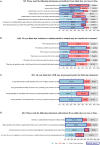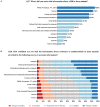Consumers' knowledge, attitude, and behavior towards antimicrobial resistance and antimicrobial use in food production in China
- PMID: 36211698
- PMCID: PMC9540231
- DOI: 10.3389/fpubh.2022.1015950
Consumers' knowledge, attitude, and behavior towards antimicrobial resistance and antimicrobial use in food production in China
Abstract
Background: Antimicrobial resistance (AMR) can be induced by overuse or misuse of antimicrobials. Few researches were involved in consumers' knowledge and attitude toward antimicrobial use (AMU) in food production. This study was designed to investigate the knowledge and awareness, perception, and attitude of Chinese consumers toward AMU in food production. Their behavior, purchase intention of antimicrobial-free food products, and confidence in information sources were also investigated.
Methods: As a descriptive cross-sectional study, an online electronic survey questionnaire was conducted between February 25 and March 8, 2022, involving 1,065 consumers in China. Factor analysis was conducted to identify underlying patterns of the attitudes and information sources. Spearman correlations were employed to determine the relationship between knowledge, attitudes and the intention to pay extra. The differences in knowledge and attitudes were performed by independent t-test and one-way analysis of variance (ANOVA) test, and the difference in intention was performed by Chi-square test, when compared with demographic factors.
Results: The findings showed that even though 75.0% of them heard of AMR, and 48.2% knew the definition of AMR, the level of consumers' knowledge of AMU in farming production and food regulations in China was not high (48.9% of participants replied correctly). About half viewed AMU and AMR as a potential risk to their health. Of these participants, 61.3% claimed that they were more likely looking for specific information about AMU on food packaging, and 58.3% changed their eating or cooking habits due to the concern. In addition, 79.8% were willing to pay extra for antimicrobial-free food products. Information sources from professionals and authorities were considered more accurate than those from media, the internet, word of mouth, and others.
Conclusions: Chinese consumers had insufficient knowledge and neutral attitudes about AMU in farming production and food regulations in China. A large proportion of the participants were willing to purchase antimicrobial-free food products. Most of them obtained related information from the media. This study highlighted the importance of updated education and effective communication with consumers in China. It helps to develop the reliable foodborne AMR surveillance system along food chain and improve government communication and consumer awareness.
Keywords: China; antimicrobial resistance (AMR); antimicrobial use (AMU); consumer; food production; knowledge-attitude-behavior.
Copyright © 2022 Ding, Gao, Ding, Huang, Zhao and Yang.
Conflict of interest statement
The authors declare that the research was conducted in the absence of any commercial or financial relationships that could be construed as a potential conflict of interest.
Figures




Similar articles
-
Factors influencing Scottish dairy farmers' antimicrobial usage, knowledge and attitude towards antimicrobial resistance.Prev Vet Med. 2023 Dec;221:106073. doi: 10.1016/j.prevetmed.2023.106073. Epub 2023 Nov 9. Prev Vet Med. 2023. PMID: 37952280
-
Knowledge, attitude and practices of Swiss dairy farmers towards intramammary antimicrobial use and antimicrobial resistance: A latent class analysis.Prev Vet Med. 2020 Jun;179:105023. doi: 10.1016/j.prevetmed.2020.105023. Epub 2020 May 1. Prev Vet Med. 2020. PMID: 32446003
-
Knowledge, attitudes, practices and risk perception of rural poultry farmers in Cameroon to antimicrobial use and resistance.Prev Vet Med. 2020 Sep;182:105087. doi: 10.1016/j.prevetmed.2020.105087. Epub 2020 Jul 11. Prev Vet Med. 2020. PMID: 32726706
-
Characterisation and mapping of the surveillance system for antimicrobial resistance and antimicrobial use in the United Kingdom.Vet Rec. 2021 Apr;188(7):e10. doi: 10.1002/vetr.10. Epub 2021 Feb 10. Vet Rec. 2021. PMID: 33835538 Review.
-
Burden assessment of antimicrobial use and resistance in livestock in data-scarce contexts.Rev Sci Tech. 2024 Aug;43:168-176. doi: 10.20506/rst.43.3529. Rev Sci Tech. 2024. PMID: 39222100 Review. English.
Cited by
-
Consumers' perspectives on antibiotic use and antibiotic resistance in food animals: a systematic review.NPJ Sci Food. 2025 Mar 10;9(1):29. doi: 10.1038/s41538-025-00381-3. NPJ Sci Food. 2025. PMID: 40064956 Free PMC article.
-
Understanding Consumers' Purchase Intention Towards Meat Produced Without Preventive Antibiotic Use.Foods. 2024 Nov 25;13(23):3779. doi: 10.3390/foods13233779. Foods. 2024. PMID: 39682851 Free PMC article.
-
The effect of information provision on consumers' risk perceptions of, support for a ban, and behavioral intention towards the preventive use of antibiotics in food animals.BMC Public Health. 2024 May 28;24(1):1428. doi: 10.1186/s12889-024-18859-2. BMC Public Health. 2024. PMID: 38807103 Free PMC article.
-
Impacts of access to legume- or grass-based pasture on behaviour, physiological responses and bacterial load of laying hens.Heliyon. 2024 Jul 18;10(14):e34780. doi: 10.1016/j.heliyon.2024.e34780. eCollection 2024 Jul 30. Heliyon. 2024. PMID: 39149081 Free PMC article.
-
Consumer Preferences and Attitudes towards Antibiotic Use in Food Animals.Antibiotics (Basel). 2023 Oct 16;12(10):1545. doi: 10.3390/antibiotics12101545. Antibiotics (Basel). 2023. PMID: 37887246 Free PMC article.
References
-
- World Health Organization . Antimicrobial resistance. (2021). Available online at: https://www.who.int/news-room/fact-sheets/detail/antimicrobial-resistance (accessed January 12, 2022).
-
- World Health Organization . Global antimicrobial resistance surveillance system: manual for early implementation. Geneva: World Health Organization; (2015). 36 p. Available online at: https://apps.who.int/iris/handle/10665/188783 (accessed December 31, 2021).
-
- Ricke SC, Jarquin R, Hanning I. 16 - Antimicrobials in animal feed: benefits and limitations. In: Fink-Gremmels J. editor. Animal Feed Contamination. Woodhead Publishing Series in Food Science, Technology and Nutrition. Woodhead Publishing; (2012). p. 411–431 10.1533/9780857093615.4.411 - DOI
Publication types
MeSH terms
Substances
LinkOut - more resources
Full Text Sources
Medical
Research Materials

